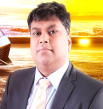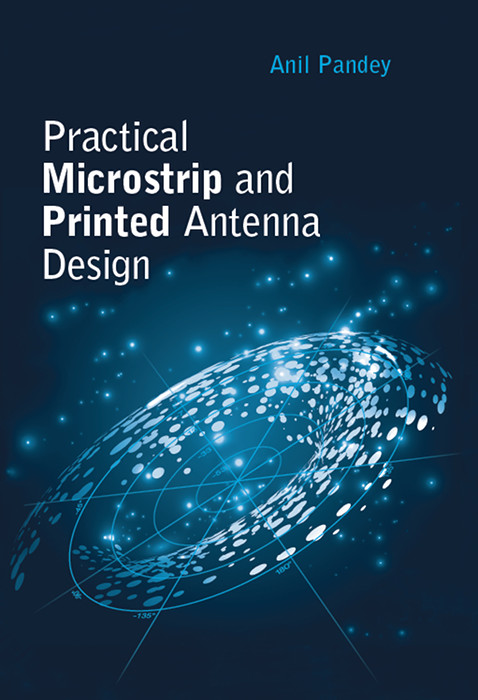Please introduce yourself and your book(s)!
My name is Anil Pandey and I am Principal RnD engineer in Keysight Technologies. I qualified for my Master of Technology in RF microwave engineering from the Indian Institute of Technology in India. After my studies, I joined as a scientist at the Indian Space Research Organization (ISRO) then Agilent Technologies. In 2014, Keysight pinned-off from Agilent and now I am working in Keysight as a technical leader.
I have conducted over 17 years of research in the area of RF, Microwave and antenna designs. In the spring of 2019, my book, “Practical Microstrip and Printed Antenna Design” has been published by a well-reputed publisher, Artech House and I am delighted. I have written this technical book based on my research in the area of RF, Microwave and antenna designs.
My book focus is more on practical antenna design than theoretical analysis. There are many excellent textbooks on antenna theory, mathematical formulations, and design. The book represents a good reference for experienced RF engineers and an excellent starting point for novice engineers eager to learn more about the challenges of antenna designs.
What is/are the real-life story(ies) behind your book(s)?
I often get asked about my path to be a technical book author and I tell, I wrote this book because I have a passion for the subject I have written. In my professional career, I have always done research, design, and development on microstrip and printed antennas. It’s not easy trying to fit in writing a technical book when our lives are taken up with other things but, if the urge is strong, it will find a way through whoever you are and whatever your situations. This was certainly my experience.
What inspires/inspired you to write a book?
A technical book will give you prominence in your area of work. You also enhance your standing amongst your friends, colleagues, and even relatives. Frankly speaking, I never thought to be the author of a technical book. My first memory of my decision was reading collection of my own technical research papers then telling myself I wanted to write a book one day based on my research work. Of all the things that have changed my life and my career, nothing comes close to my regular technical paper writing habit.
It’s the keystone habit that created a ripple effect into nearly every area of my work. It took me over three years to achieve my dream. Writing a book can be both an exciting and exhausting experience but it can help your career by giving you visibility, recognition from your community and set you apart as an achiever.
How do you deal with creative technical block?
Creativity is an important element of any technical book. The way you present complicated technical information to readers, it should be an easy way. This probably sounds like a smooth trajectory on the surface, but it won’t surprise many to know that it has, in fact, been a long and unpredictable journey with a few significant factors along the way. As we all know, creativity doesn’t come overnight. You must work for it and work hard. It takes hustle, determination, and plenty of sleepless nights slaving away at your computer. One key being a good author is to always keep reading and learning latest technologies.
Do you have tips on choosing titles and covers?
Title of the book is the first thing the resonate readers. I spend substantial time and energy finding the right book title. I then decided that I would write books with titles that reflect the key elements of the book that is practicality of the designs. The book cover was designed by publisher and it’s very nice and appealing.
How do bad reviews and negative feedback affect you and how do you deal with them?
I am open to all kind of negative and positive feedback and I am always happy to get this kind of feedback. Infect for me, negative feedback is more important because it helps me to improve on my technical subject.
What are the biggest mistakes you can make in a book?
Becoming a good author doesn’t happen by chance. Before you begin writing at all, think carefully about the overall structure of the book. Many authors get derailed from their main technical subject that’s not good for reading and some time, having too many technical details lead to confusion. I didn’t want to go overboard with many technical formulations because designers find it too difficult to start a practical antenna design. That being said, you have to make a good balance between theory and practical design aspect.
Most of my research came from my day job as an antenna engineer. Writers should read what’s selling well in your genre and what’s the gap that can be filled by your book. It’ll help you to understand what works with that reader and help you target ways to improve and make your book stand out from the mass.
What were the best, worst and most surprising things you encountered during the entire process of completing your book(s)?
Since this was my first technical book, I would say the best part was sharing with readers the practical aspects of antenna design. But honestly, I would say it’s not an easy job but writing the book was a great learning experience in which I had to correct my own conclusions presented in previous works. The whole book technical review and publishing process was surprising for me, and meeting publication timeline is also tough sometimes. I am currently a full-time research engineer so time can sometimes be an issue or just an excuse for procrastination or writer’s block. I scheduled my writing hours on my weekends. I committed myself to publish my first book through tradition publication or if not accepted then self-published it. But I was willing to do the work, so my dream of publishing a book is now reality.
Do you tend towards personal satisfaction or aim to serve your readers? Do you balance the two and how?
There are excitements from being a published author: Your name in print on a book cover, having your words in print, and the respect of having accomplished publishing your work and it gives me personal satisfaction. On the same time, I have written this book so that readers can gain from my research and design experience in this field.
What are your plans for future books?
As of now, I don’t have any plan, but I am sure will write something new in future.
Tell us some quirky facts about yourself
Personally, I love to learn new technologies in all areas. The hobby that I could never give up is traveling. I love travel so much because it gives me opportunity to visit new places and making new friends.
About the Author

Anil Pandey is the principal technical leader at Keysight Technologies. He has published 42 research papers in journals, proceedings, national and international conference and holds two patents. He received his Master of Technology in RF microwave engineering from the Indian Institute of Technology. He has conducted over 17 years of research in the area of printed antennas. He has worked on various projects involving a wide range of antenna technology, including printed antennas, broadband microstrip antennas, phased array systems, 5G, mobile phone antennas, automotive radar, SAR antennas, and multilayer microstrip arrays. He has successfully completed many research projects and managed several projects in these fields.
